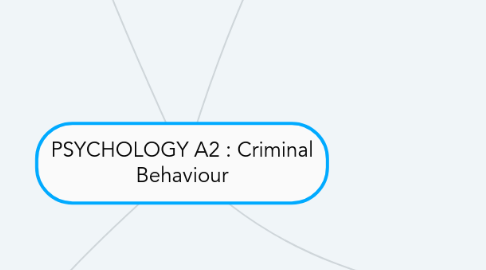
1. BIOLOGICAL EXPLANATION
1.1. Role of the Amygdala
1.1.1. Structure and Function
1.1.1.1. Functions together with orbitofrontal cortex, which is thought to influence self-control, regulate impulsive behaviour and inhabit aggression
1.1.1.1.1. EXAMPLE: Papez (1937) and Maclean (1952), amygdala is highly connected to emotional behaviour. Has a widespread influence on brain functioning and behaviours associated with emotion, motivation and social interaction. plays a major role in how we assess and respond to environmental threats, hence why its important in determining aggressive behaviour.
1.1.2. Aggression
1.1.2.1. EXAMPLE: Emil et al (2007) investigated the effects of the amygdala on aggression by studying people with intermittent explosive disorder (IED), each pp viewed images of faces whilst having a fMRI scan. PP's with IED showed high levels of amygdala activity when viewing angry faces, concluding an association between amygdala activity and processing of aggressive emotions - study had high realism due to angry faces being part of everyday life.
1.1.3. Fear Conditioning
1.1.3.1. Yu Gao (2010) proposed that as we lean as children to inhibit our aggressive and antisocial behaviours through fear conditioning - we learn that aggressive behaviour leads to punishment/neg outcomes. The amygdala is involved in processing fear, a dysfunction of the amygdala means a child cannot identify social cues that indicate a threat and doesn't link punishment to aggressive behaviour, therefore fear conditioning is disrupted.
2. INDIVIDUAL DIFFERENCES
2.1. Cognitive Factors
2.1.1. Cognitive Distortions
2.1.1.1. A form of irrational feelings/thinking. Distortions are common, where reality becomes twisted so whats perceived isn't a correct representation of reality, the result is that a persons perceptions of events/situations are wrong. Distortions allow an offender to deny or rationalise their behaviour.
2.1.2. Hostile Attribution Bias
2.1.2.1. Attribution refers to what we think we we observe someones actions and draw an inference about what it means. E.G. If a person is smiling, you might infer that they are communicating that they like you. A hostile attribution bias is when someone has a leaning towards always thinking the worst, E.G. If someone smiles at you, you'll think that person is thinking badly about you. These negative interpretations then lead to more aggressive behaviour.
2.1.3. Minimalisation
2.1.3.1. Both magnification and minimalisation are cognitive distortions where the consequence of a situation are either over or under exaggerated. Minimalisation can explain how an offender may reduce any negative interpretation of their behaviour before and after a crime is committed. This helps an individual accept the consequences of their own behaviour and negative emotions can be reduced.
3. Inherited Criminality
3.1. genetic factors
3.1.1. one or more genes predispose people to criminal behaviour.
3.1.1.1. EXAMPLE: Raine's Twin studies; identical (MZ) and non-identical (DZ) twins were compared. delinquent behaviour of twins was reviewed and found 52% concordance for MZ twins and 21% for DZ twins.
3.2. Diathesis-stress (environmental factors)
3.2.1. Current thinking in terms of EPIGENETICS proposes an interplay where genes are 'switched' on or off by EPIGENOMES which would be effected by an environmental factor
3.2.1.1. EXAMPLE: Childhood maltreatment.
3.3. Candidate Genes
3.3.1. Two genes have been linked to criminal behaviour, MAOA and CDH13
3.3.1.1. EXAMPLE: Brunner et al (1993) analysed data from 28 male members of a Dutch family who had histories of impulsive and violent criminal behaviour. They all shared a gene.
3.4. Differences in the brain
3.4.1. Criminal genes may cause differences in key areas of the brain (neurotransmitters)
3.4.1.1. EXAMPLE: Raine (2004) cited 71 brain imaging studies showing murderers, psychopaths and violent individuals had reduced functioning in the prefrontal cortex (area that regulates emotion)
4. Eysnecks Theory
4.1. Theory of personality
4.1.1. Eysneck developed a general theory of personality based on the idea that character traits (e.g. moodiness and talkativeness) tend to cluster along 3 dimensions.
4.2. Dimensions
4.2.1. EXTROVERSION - Aka extroverts, characterised by being outgoing and positive attitude. INTROVERSION - Aka introverts, characterised by being quiet and less positive attitude. NEUROTIC - Tendency to experience negative emotions (anger and depression). PSYCHOTIC - Egocentric, aggressive, impulsive, lacking in empathy and unconcerned with other people.
4.3. Biological Bias
4.3.1. Theory suggests each trait has a biological bias which is mainly innate, its claimed 67% of variance for traits due to genetic factors.
4.3.1.1. Extroversion is determined by the overall level of arousal in a persons nervous system. A person whos under-aroused requires more stimulation whereas an over-aroused person avoids this. (EX;UNDER -AROUSED, IN;OVER-AROUSED.
4.3.1.2. Neuroticisim is determined by the level of stability (re-activity) in the sympathetic nervous system, E.G. How much a person responds to situations of threat (fight or flight) A neurotic person is someone who is slightly unstable and reacts/easily gets upset. At the opposite end of this dimension is the 'stable' personality, a more nonreactive nervous system and calm under pressure.
